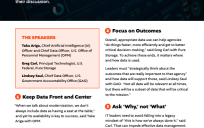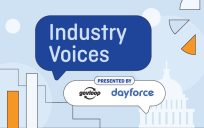Every week when I drive my son to volleyball practice, I pass a “turtle crossing” street sign. Farther along that same road, the turtle sign appears again but with a “deer crossing” sign right below it. When the second sign appears, it’s a mental trick for me to continue to watch the ground for low, slow-moving creatures while also watching a higher sight line for sprinting deer. I’m also making this drive at dusk when visibility is already a challenge. The double level of vigilance required is almost comical. But it’s necessary to avoid disaster for myself, my car, or either one of the animals.
When I worked in government — and this holds true for all levels:  federal, state, and local — I often felt caught between attending to deer and turtles simultaneously. Elected officials with bold ideas and promises to keep wanted to move mountains in a sprint. Layers of process, oversight, resource constraints, and valid strategic planning necessitated a slower approach.
federal, state, and local — I often felt caught between attending to deer and turtles simultaneously. Elected officials with bold ideas and promises to keep wanted to move mountains in a sprint. Layers of process, oversight, resource constraints, and valid strategic planning necessitated a slower approach.

Unlocking Solutions
Most public sector professionals want to create solutions and improve lives through innovative service delivery. Balancing idealism with realism is the norm, as we strive for progress and measurable results. There are certainly ways to achieve quick, visible wins, particularly in citizen engagement and the use of mobile apps. GovLoop touched on this in “2 Cities Using Digital Channels to Improve Engagement.”
The best long-term strategy for moving the needle on any of society’s most pressing issues is to create solution-bearing connections. These sometimes unglamorous but always necessary connections occur at the foundational level of an agency’s digital infrastructure. It’s all about how technology can facilitate easy access to the right information at the right time for smart decisions. When policy is based on accurate, real-time information from all relevant sources, successful solutions take shape. The right technology is the bridge that brings solution-bearing insight (by way of data) to government leaders.
Building Data Maturity
Public sector staff as well as elected leaders have long recognized the value of leveraging data to address some of their constituents’ most pressing challenges. The COVID-19 pandemic reinforced data’s strategic value in making decisions in a rapidly changing environment. It also exposed gaps in governments’ ability to access siloed information from disparate systems in real time.
Evidence-based policymaking is a struggle at best when legacy IT systems can’t efficiently move the large amounts of data needed for actionable insight. Solving problems requires governments to leverage technology to break out of burdensome silos.
Following the key steps below can help leaders advance data sharing and data use across agencies and departments to achieve policy goals:
- Evaluate existing data assets and existing staff skillsets.
Think about the types of data you collect and what might be most valuable to constituents. Understand how many employees manage and analyze data, and whether they have both the technical and line-of-business skills to share insights across the organization. - Identify promising use cases and desired outcomes.
Don’t manufacture a purpose. Work collaboratively with business owners to identify where decisions would have greater impact if they were enabled by real-time data and insights from multiple information sources. - Cultivate trust and address cultural barriers to data sharing.
Building support for data sharing involves clearly communicating its benefits to each participating department or agency. - Strengthen data governance to protect sensitive data.
Governance and policy are the most significant levers to ensure data is accessed and used appropriately. Ensure data is secure and sensitive constituent information is accessible only to authorized users. - Focus on equity in data system planning.
There needs to be transparency about how data is used, how it’s collected, and who is and isn’t in the dataset. Consider these issues within dataset or data-analytics algorithms up front. - Ensure data quality, standardize common data types, and address data lifecycles.
Data-driven decisions are only as good as the quality of the information they draw from. Ensuring data quality begins with understanding appropriate uses for existing datasets within an agency or department and considering factors such as consistency, formatting, and timeliness of the information. - Provide staff support and documentation.
Craft manuals that detail the best way to structure data along with a data dictionary to demystify the process. Provide simple one-page summaries and follow up with more detailed materials to educate staff. - Evaluate technology needs to support data-driven decision making.
The key is to get high-quality data into the hands of subject matter experts and policymakers. Explore cloud-based technology options that aggregate and catalog information from multiple sources in a flexible, centralized platform.
These efforts tend to snowball in a positive way, creating a data culture within agencies that drives innovation and pushes data initiatives forward.
Advancements in technology and the post-pandemic impetus for modernization provide new opportunities to justify investments in data systems that move ideas to policy and policy to measurable success.
Interested in becoming a Featured Contributor? Email topics you’re interested in covering for GovLoop to [email protected]. You can view all featured contributor articles here.
Meredith Trimble is a former municipal official and Town Council Acting Chair, who focused on strategic planning, annual budgeting and bonded infrastructure projects. Her government experience also includes posts in both federal and state-level executive branch agencies; Associate Editor of the Federal Election Commission’s FEC Record; and Director of Education for the CT Office of State Ethics. In her current role as a Content Manager, Editorial with Tyler Technologies, Inc., she writes content to help empower those who serve the public. Her current focus is to help facilitate data-enabled organizations and create connections between governments and those they serve.





Leave a Reply
You must be logged in to post a comment.